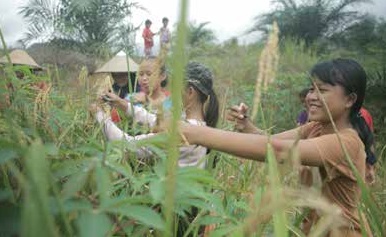Goals
- Support the emergence of a generation of indigenous Dayak Kanayatn youth who are culturally creative.
- Re-explore the history and safeguard the ancestral knowledge of the Dayak Kanayatn.
- Strengthen, in the indigenous youth, the interest in caring about their territories, and wanting to return to their own villages.
- Develop good inter-generational communication and living heritage transmission between the elders, the youth, and the children.
Description
Sekolah Adat Samabue (Samabue Indigenous School or SAS) is a self-funded, volunteer-run indigenous school of the Dayak Kanayatn indigenous people from Menjalin in West Kalimantan province, Indonesia. The school was founded in February 2016, after the young indigenous leader Modesta Wisa, gathered a core team of elders, youths and women from the indigenous Dayak Kanayatn communities to think about why it was important to promote indigenous education and the kind of classes that could be offered. As a result, they decided to initiate a school to encourage children and youth to care about cultural survival issues by providing them with a solid root in their own traditional knowledge and living heritage. Thus, Samabue after-school programmes are considered part of indigenous people’s mainstream education parallel to the state-run school, as both are considered essential for the community’s children’s education.
SAS functioning and network
The Samabue Indigenous School runs in eight villages as afternoon learning clubs, all of which have indigenous volunteers as teachers. Volunteers are the core base for the school’s self-funding operation. Volunteers see their expenses as a contribution to provide cultural education for the children of the community. This system also allows the school to keep its independence in setting a communitarian agenda, which is considered crucial to the school’s success.
The eight Samabue programmes also support each other through teachers and students’ exchanges. The teachers’ exchange encourages sharing the living heritage of elder bearers with the neighbouring villages that could have lost some specific knowledge and skills. The students’ exchange allows children to experience their culture in different environmental contexts. Finally, villages may also exchange techniques as well as seeds, important for the forest conservation.
SAS educational approach and methodology
The Samabue schools have developed a holistic inter-connected approach that they consider part of their indigenous education. The aim is to ensure their living heritage will not disappear and the nature that surrounds them will be conserved for the next generations.
The programmes are customized to the ecological circumstances, teachers’ availability and the specific needs, knowledge and skills of the communities in each village. However, the eight schools follow the educational approach based on the principle ‘Everyone is a teacher and nature is my school’.
One of the educational pillars is then linked to the teaching role of community members. Elders are recognized as a source of knowledge regarding history, customs and identity, and play a key role in the transmission of living heritage. The knowledge and engagement of the youth are considered equally important to the school, this is why many teachers are young community leaders. Fostering this commitment and exchange between generations - elders-youth, elders-children, youth-children is considered another key component of the school’s functioning and success. Besides, positioning youth and elders as teachers promotes a child-friendly and familiar setting for children that strengthens the attachment to the school.
A second pillar is related to nature, specifically to conservation awareness. Teaching is mostly held outdoors in the backyards of teachers’ homes, or as excursions to local forests and fields. For the core teaching team, it’s vital to have territory-related practices linked to their way of living. Most curricula focus on teaching language, spiritual culture and on education regarding environmental threats that jeopardize indigenous livelihoods. All these topics are addressed through farming, crafts, storytelling, music, dance, martial arts and forest excursions.
The Samabue Indigenous School is considered as an indigenous youth movement. Youth who care about their communities and their territories seeking to raise a future generation of Dayak Kanayatn.
Outputs
- Eight Samabue after-school programmes have been created.
- Foster environment conservation through the transmission of their ancestral knowledge.
- Knowledge transfer through generational exchange on living heritage and environment conservation.
- Young indigenous leaders’ empowerment to mobilise their living heritage as a relevant contemporary instrument to protect their livelihoods and natural landscapes.
- Environmental conscience raise.
The content of the projects and documents referenced in this platform do not imply the expression of any opinion whatsoever on the part of UNESCO, including designations employed concerning the legal status of any country, territory, city or area or of its authorities or concerning the delimitation of its frontiers or boundaries.
